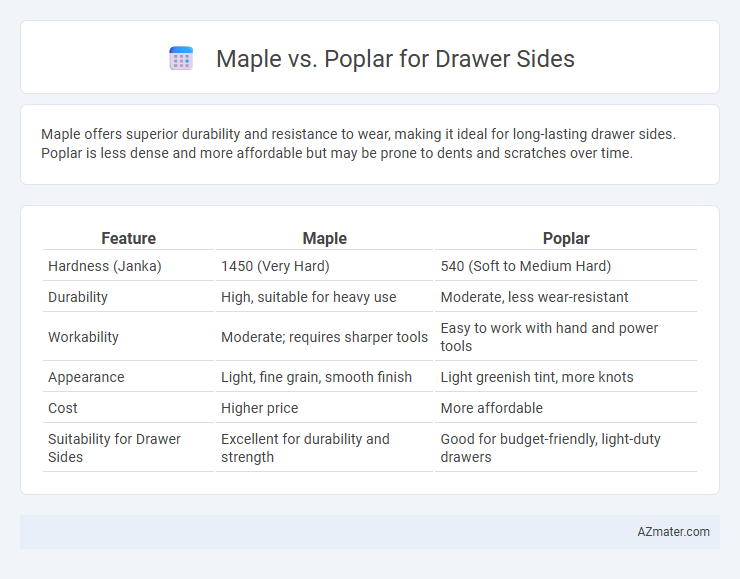Maple offers superior durability and resistance to wear, making it ideal for long-lasting drawer sides. Poplar is less dense and more affordable but may be prone to dents and scratches over time.
Table of Comparison
| Feature | Maple | Poplar |
|---|---|---|
| Hardness (Janka) | 1450 (Very Hard) | 540 (Soft to Medium Hard) |
| Durability | High, suitable for heavy use | Moderate, less wear-resistant |
| Workability | Moderate; requires sharper tools | Easy to work with hand and power tools |
| Appearance | Light, fine grain, smooth finish | Light greenish tint, more knots |
| Cost | Higher price | More affordable |
| Suitability for Drawer Sides | Excellent for durability and strength | Good for budget-friendly, light-duty drawers |
Introduction to Maple and Poplar for Drawer Sides
Maple and poplar are popular hardwoods used for drawer sides, each offering distinct advantages in durability and appearance. Maple is dense, strong, and exhibits a fine, uniform grain, making it ideal for drawer sides that require long-lasting strength and smooth finishes. Poplar, while softer and lighter, provides ease of machining and cost-effectiveness, making it suitable for drawer sides in budget-conscious projects or painted finishes.
Wood Characteristics: Maple vs Poplar
Maple wood features a fine, uniform grain with a hard, dense structure, making it highly durable and resistant to wear, ideal for drawer sides requiring strength. Poplar, on the other hand, has a softer texture and a more porous grain pattern, offering easier workability but less durability compared to maple. The natural color of maple ranges from creamy white to light reddish-brown, while poplar typically exhibits greenish or yellowish hues, influencing aesthetic choices alongside functional qualities.
Durability and Strength Comparison
Maple offers superior durability and strength for drawer sides due to its dense, tight grain structure, making it highly resistant to wear and impact compared to Poplar. Poplar, while more lightweight and easier to work with, lacks the hardness needed for long-term drawer side durability under heavy use. Choosing Maple ensures enhanced structural integrity and longevity in drawer construction.
Workability and Machining Ease
Maple exhibits excellent workability due to its uniform grain and density, enabling smooth cutting, shaping, and sanding for drawer sides. Poplar is softer and less dense, which facilitates easier machining and faster shaping but can lead to dents or scratches during handling. Both woods machine well, but Maple offers superior durability and a finer finish, making it preferred for high-quality drawer construction where precision is essential.
Cost and Availability
Maple offers higher durability and a fine, smooth grain, but it typically comes at a higher cost compared to poplar, which is more budget-friendly and widely available. Poplar's availability is consistent across most markets, making it a practical choice for cost-conscious projects, whereas maple may require sourcing from specialized suppliers. The price difference makes poplar ideal for economical drawer sides, while maple suits applications needing greater strength and aesthetic appeal.
Appearance and Grain Patterns
Maple exhibits a smooth, consistent grain with a light, creamy color that often features subtle, wavy patterns, providing a clean and modern look for drawer sides. Poplar typically shows a more varied grain with occasional knots and streaks, possessing a greenish or brownish hue that can lend a rustic or casual appearance. The choice between maple and poplar for drawer sides hinges on the desired visual effect: maple offers uniform elegance, while poplar delivers distinctive, character-rich patterns.
Finishing and Staining Results
Maple wood offers a smooth and consistent grain that absorbs stains evenly, resulting in a rich, uniform finish ideal for drawer sides requiring a polished appearance. Poplar, being a softer hardwood with a more porous texture, tends to blotch when stained unless properly pre-treated with a conditioner to ensure even color absorption. Finishing maple provides a durable, glossy surface that highlights its natural beauty, while poplar often requires additional sanding and sealing steps to achieve comparable staining results in drawer construction.
Suitability for Different Drawer Types
Maple offers superior durability and resistance to wear, making it ideal for heavy-use drawers such as kitchen or tool drawers that require long-lasting strength. Poplar, being softer and easier to machine, suits decorative or light-duty drawers like bedroom or office furniture where intricate designs and smooth finishes are prioritized. Choosing between Maple and Poplar depends on the drawer's functional demands, with Maple excelling in structural integrity and Poplar favored for cost-effective, customizable applications.
User Preferences and Industry Trends
Maple is favored for drawer sides due to its hardness, durability, and smooth grain, making it ideal for long-lasting furniture with frequent use. Poplar is preferred for budget-conscious projects and painted finishes because of its affordability and ease of staining. Industry trends show increasing demand for sustainable sources, with both woods commonly sourced from certified suppliers to meet eco-friendly consumer preferences.
Conclusion: Best Choice for Drawer Sides
Maple is the best choice for drawer sides due to its superior hardness, durability, and smooth finish, ensuring long-lasting performance and minimal wear. Poplar, while more affordable and easier to work with, lacks the strength and resistance necessary for heavy-use drawers. For drawers requiring robust support and a premium appearance, maple provides an optimal balance of strength and aesthetic appeal.

Infographic: Maple vs Poplar for Drawer Side
 azmater.com
azmater.com